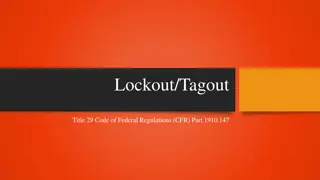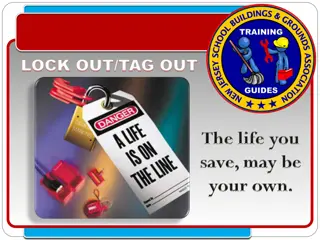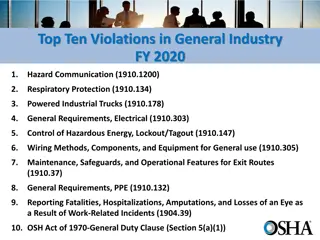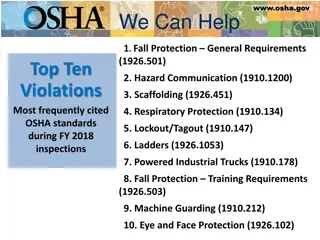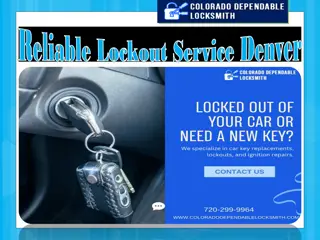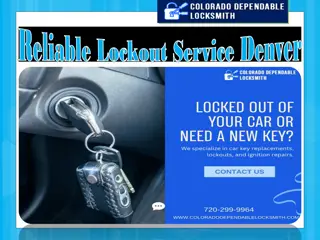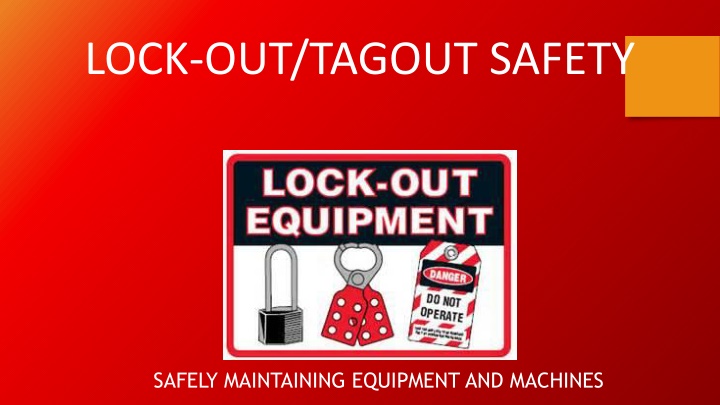
Ensuring Safety in Equipment Maintenance with Lockout/Tagout Procedures
Lockout/tagout procedures are essential for protecting workers servicing machinery from injury due to unexpected energization. Compliance with OSHA Standard 29 CFR 1910.147 is crucial to prevent fatalities and injuries. Lockout devices securely hold energy-isolation devices in the off position, while tagout devices serve as warning labels. Equipment can be powered by various sources, requiring proper lockout procedures. Employers should establish programs for energy control procedures, employee training, and inspections to maintain a safe work environment.
Download Presentation

Please find below an Image/Link to download the presentation.
The content on the website is provided AS IS for your information and personal use only. It may not be sold, licensed, or shared on other websites without obtaining consent from the author. If you encounter any issues during the download, it is possible that the publisher has removed the file from their server.
You are allowed to download the files provided on this website for personal or commercial use, subject to the condition that they are used lawfully. All files are the property of their respective owners.
The content on the website is provided AS IS for your information and personal use only. It may not be sold, licensed, or shared on other websites without obtaining consent from the author.
E N D
Presentation Transcript
LOCK-OUT/TAGOUT SAFETY SAFELY MAINTAINING EQUIPMENT AND MACHINES
Approximately 3 million workers service equipment and face the greatest risk of injury if lockout/tagout is not properly implemented. Compliance with the lockout/tagout standard (29 CFR 1910.147) prevents an estimated 120 fatalities and 50,000 injuries each year. What is OSHA STANDARD 29 CFR 1910.147?OSHA Standard 29 CFR 1910.147 states: This standard covers the servicing and maintenance of machines and equipment in which the unexpected energization or start up of the machines or equipment, or release of stored energy could cause injury to employees. This standard establishes minimum performance requirements for the control of such hazardous energy. When to use Lockout/Tagout devices. Protecting your employees from accidental start up is a necessary first step in conducting proper repairs, servicing and maintenance of machinery and equipment. Take the necessary measures to ensure that a device is set in the off position without chance of start up by using a quality Lockout/Tagout product. Establish a program consisting of energy control procedures, employee training and periodic inspections.
MACHINES CAN BE POWERED BY: Pressurized Liquids Compressed Air Coiled Springs Steam Gas Electricity BE AWARE!! Sometimes equipment and machinery is powered from multiple sources Any single source of power, even if other sources are turned off and locked out, presents a danger to workers. Follow to lockout procedures om specific equipment established by your employer.
Lockout devices hold energy-isolation devices in a safe or "off" position. This may include a padlock, blanking plate, restraining bar, chain, padlock or any device which prevents a machine from being energized or releasing stored energy. Lockout devices provide protection because they are positive restraints that no one can remove without a key or other unlocking mechanism, or through extraordinary means, such as bolt cutters. Tagout devices, by contrast, are prominent warning devices that an authorized employee fastens to energy- isolating devices to warn employees not to reenergize the machine while he or she services or maintains it. Tagout devices are easier to remove and, by themselves, provide employees with less protection than do lockout devices.
Equipment equipped with a hasp device, such as an electrical control panel or box can be locked out with a padlock or multiple lockout device and padlocks. A tagout (lockout tag) should show who locked out the equipment, as well as the time, date and department. Tagouts should be securely fastened to the locking mechanism so they don t fall off. The tags should be legible in all weather conditions and durable. Tagouts should only be applied and removed by the same individual. A tagout warns others that an energy source is locked out in the shut off position and should not be operated. Whenever possible, other locking devices should be used with a tagout.
Determine who will apply locks and tags If there are multiple maintenance employees, each member should apply their own lock/tag. At least one employee should apply a lock/tag to all the lockout points. Only the person who applied the lock/tag removes it If there are multiple lockout points and members of the maintenance team, team leaders should remove their locks after all others have been removed. Before removing locks, be sure All safety guards are securely back in place All work is complete and tools are put away All workers are positioned correctly to start-up All controls are positioned correctly and machine is operation ready Follow the predetermined company sequence of unlocking and untagging the lockout points to return the machine to service.
Continued Employee Training and Education All employees (and outside contractors) should have a basic understanding of lockout safety, tags and locks. Your employer will provide education and training specific to your machinery and workplace. Safety is everyone s responsibility! Lockout Tagout Safety Training








